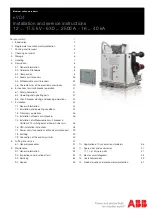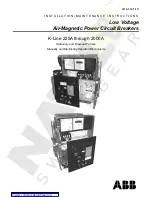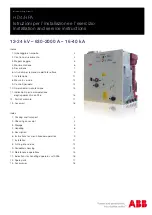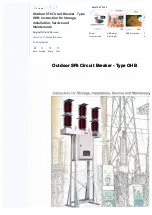
L2275
Emax UL
39/132
Doc. N°
Mod.
RH0109002
Apparatus
Scale
Page N°
13.7.4.2 Protection G with external toroidal transformer “Source Ground Return”
The second, also called “Source Ground return”, can be carried out when there is the need to check operation of a machine
(transformer or generator or motor etc.) which has star configuration of the windings.
The protection is carried out by physically positioning an external toroidal transformer on the cable connected from the star centre of the
machine to the earthing connection point.
The induced current on the winding of the toroid is proportional to the fault current which in this case transits exclusively in the above-
mentioned toroid.
To work with this mode it is necessary to set Tor. selec.:Ext.
The external toroid must be connected to the PR112 by means of a corded shielded tw o-wire cable (see note A to par.
11.2.2) with a length not exceeding 15m . The shield must be ear thed both on the circuit-breaker side and on the tor oid
side.
It is indispensable for the star centre to be connected openly to earth and that this is not also used as a neutral conductor (as in the TNC
system), making a protection according to the TT system.
The nominal values of the current sensors available are given in the table on page 48.
In single-phase self-supply, protection G is onl y active if the primary current is higher than 0.4 x In. When the phase current value
is above 4 x In , function “G” excludes itself since in this case there are the other protections which inter vene as the fault is
considered a phase fault.
13.7.4.3 Zone selectivity “G”
By means of the keyboard, it is possible to enable or disable the zone selectivity function “G”.
Cabling of zone selectivity “G” is alternative to the one for “S” and operation is only guaranteed when there is an auxiliary voltage.
The other characteristics are the same as those for zone selectivity “S”.
13.7.5 Signal of phase unbalance “U”
The signal, which can be excluded, generates a warning message in the case when unbalance between two or more phases higher than the
set threshold I6 is determined.
The percentage of unbalance is calculated as follows
100
.
%
max
min
max
⋅
−
=
I
I
I
Sbil
, where I
max
is the maximum and I
min
min the minimum phase current.
13.7.6 Protection against overtemperature inside the “OT” release
A sensor which monitors the temperature inside the unit is placed inside the PR112 unit.
This allows signalling of the presence of abnor mal temperatures, which could cause temporary or contin uous malfunctions of the microprocessor.
This protection has two alarm levels:
– On exceeding the first fixed threshold at 70°C, there is a prealarm signal, when there is auxiliary voltage the rear illumination of the display
is disabled.
– On exceeding the second fixed threshold at 85°C, there is an alarm signal and circuit-breaker opening if the “OverTemper Trip” function
is enabled.
13.7.7 Load control “K”
This function is carried out in combination with the accessory PR020/K signalling unit and the PR112 release is operating with Auxiliary Power
Supply.
There are two distinct protection curves with threshold currents and trip times lower than those selectable with protection L, which can be
used for the following two applications:
1. disconnection of two distinct loads (2 curves with inverse time t=k/I
2
);
2. connection and disconnection of a load (curve with adjustable delay t=k for connection and with inverse time t=k/I
2
for disconnection)
These protections allow single loads to be connected/disconnected before the protection for overload L intervenes to definitively open the
circuit-breaker.
13.7.7.1 Disconnection of two loads
Ic1 = load n°1 disconnection threshold
Ic2 = load n°2 disconnection threshold
t (Ic1) = load n°1 disconnection time (minimum trip time:190ms)
t (Ic2) = load n°2 disconnection time (minimum trip time: 375ms)
The protection is excludable, for both the loads individually, by selecting the [Off] value for the threshold.
Functionality:
The two protections use trip curves similar to those used b y protection “L”, b ut with lower thresholds and shor ter times.
The trip curves to be used are those of protection “L”. No thermal memor y is foreseen.
















































